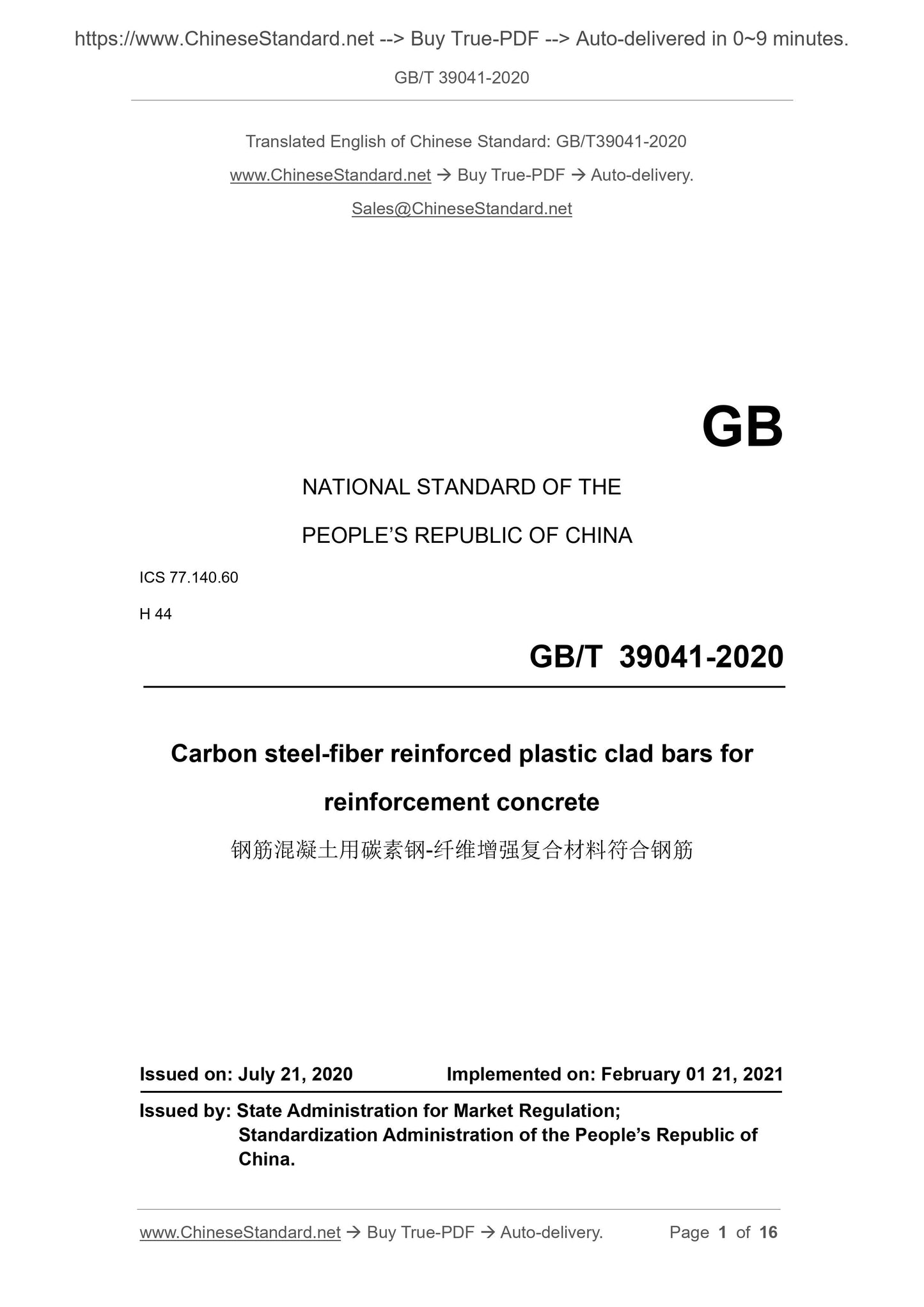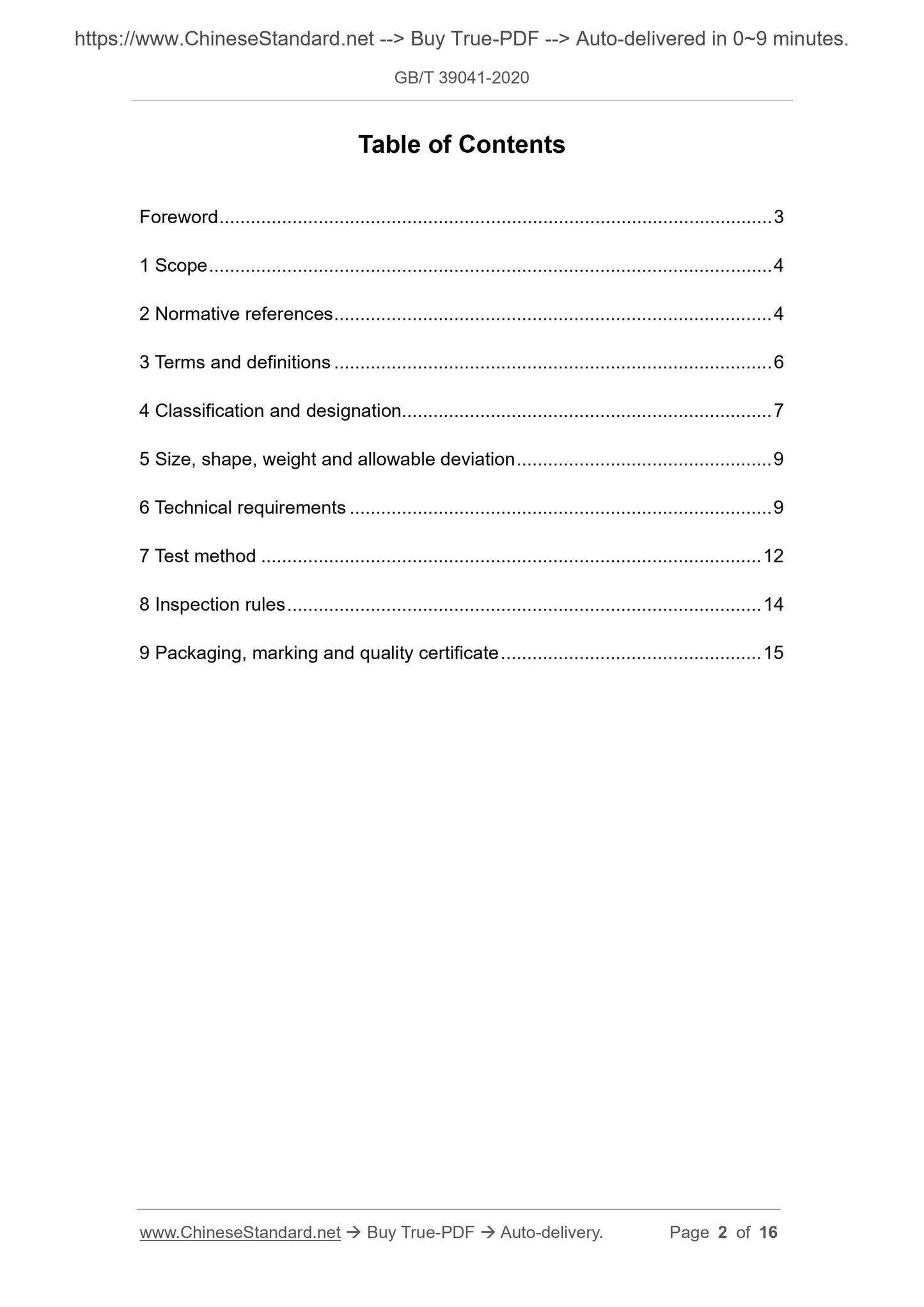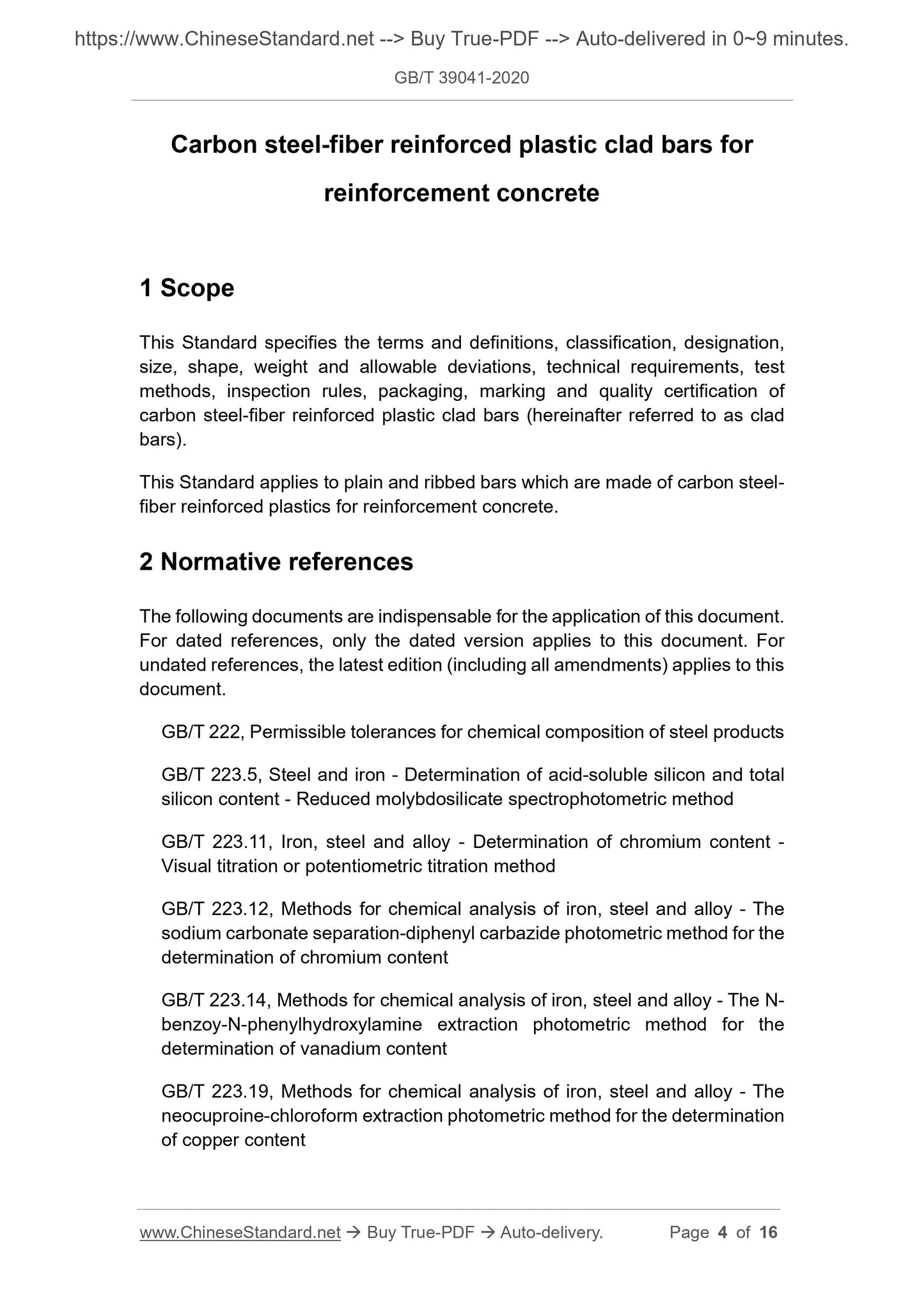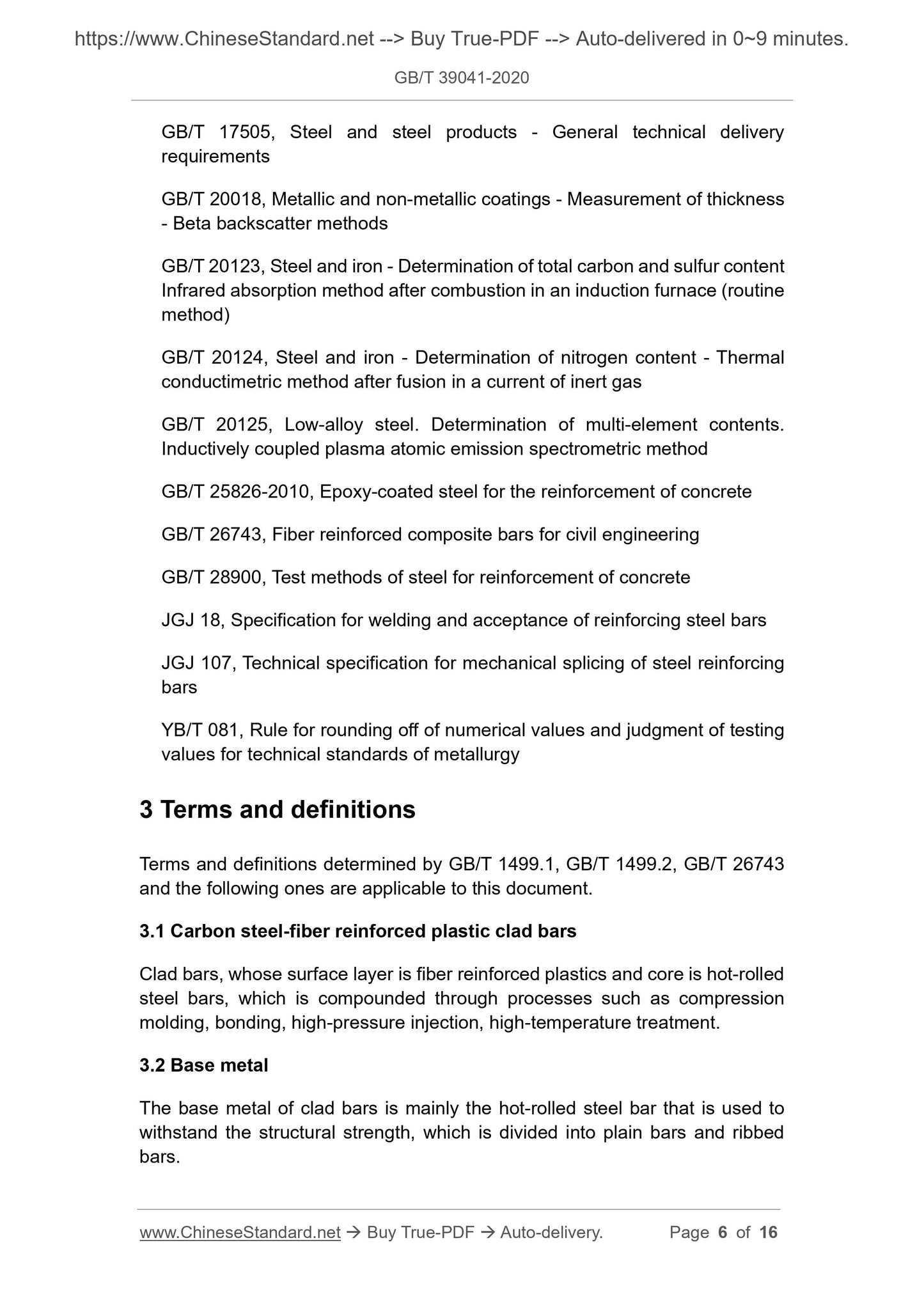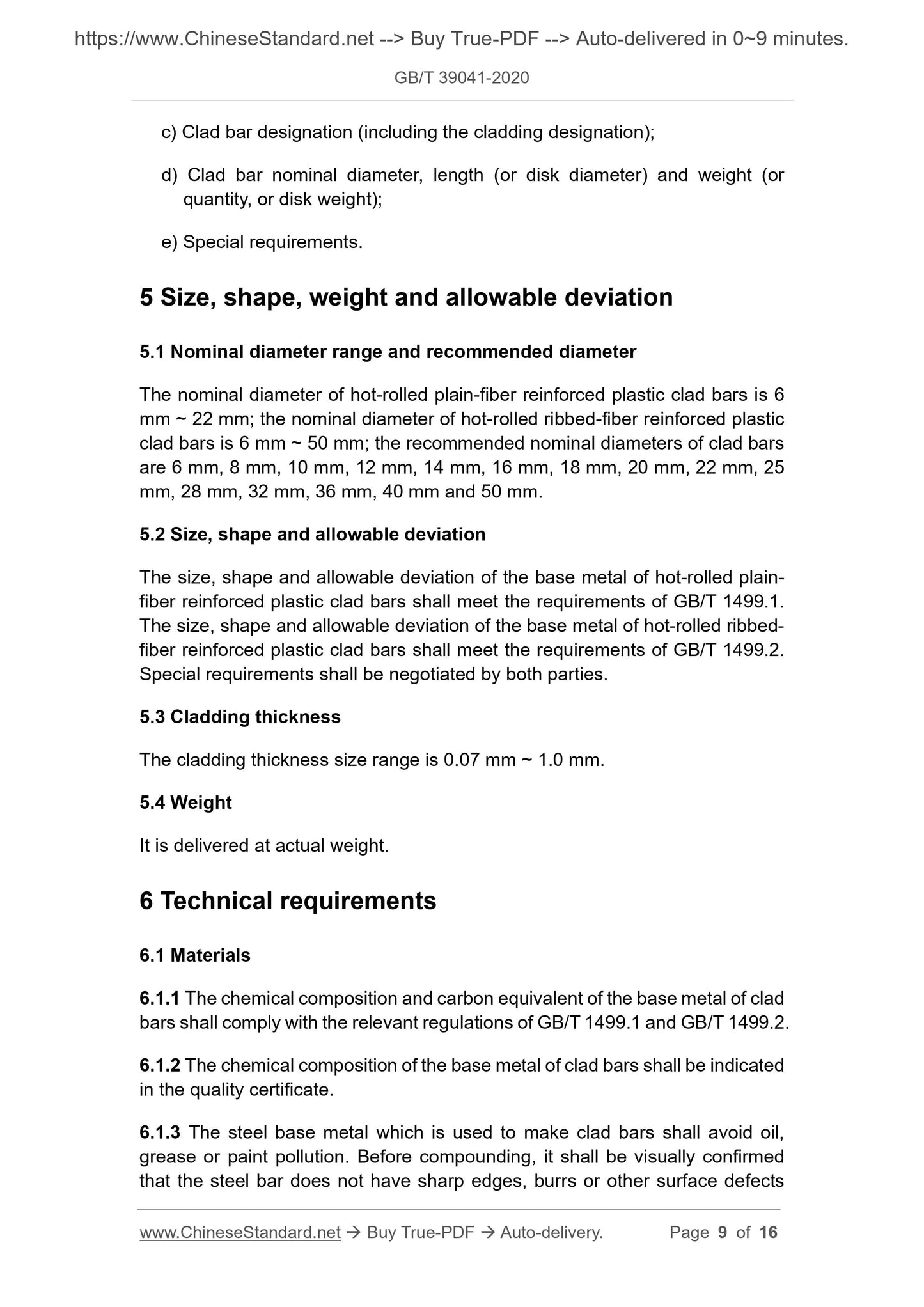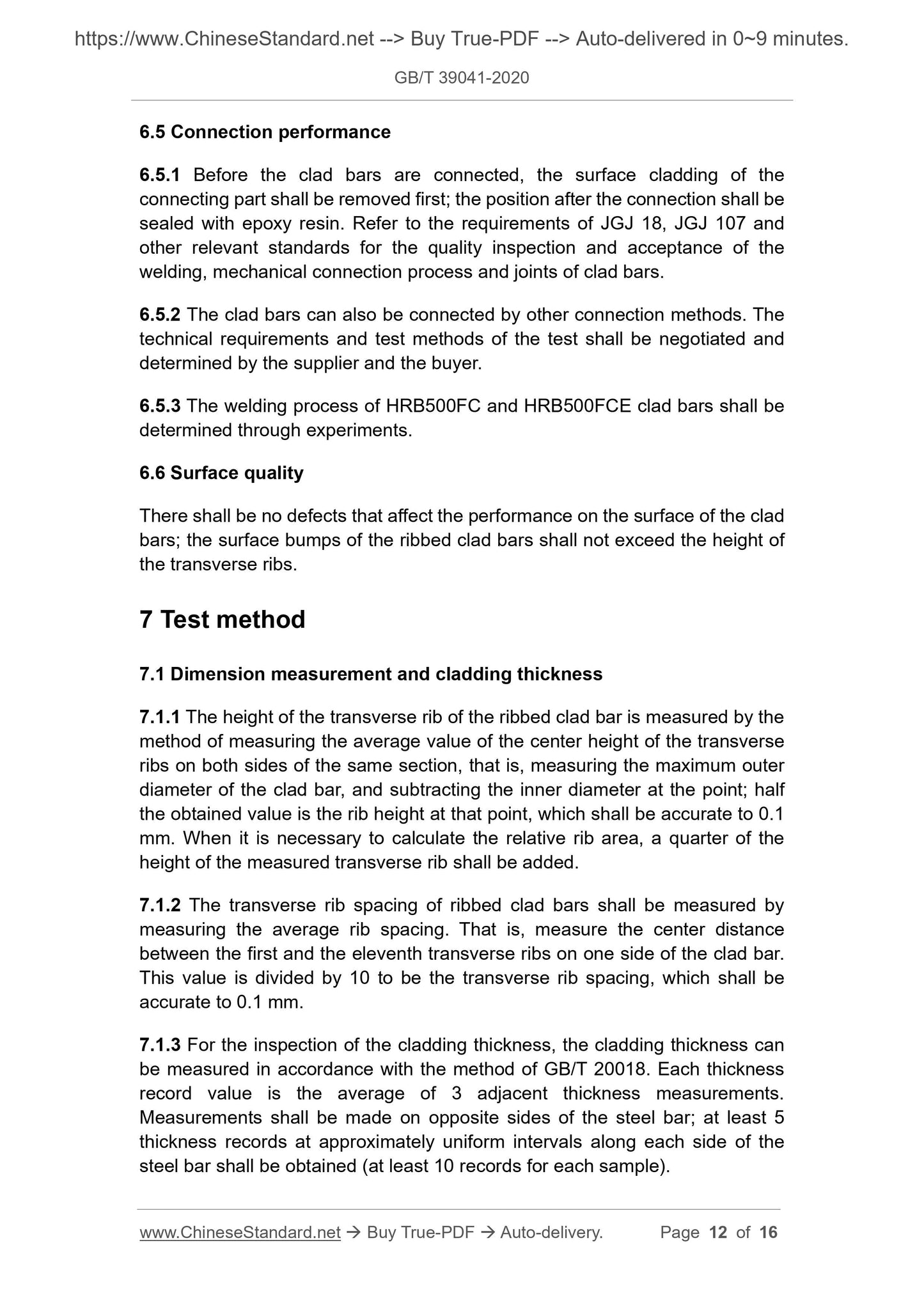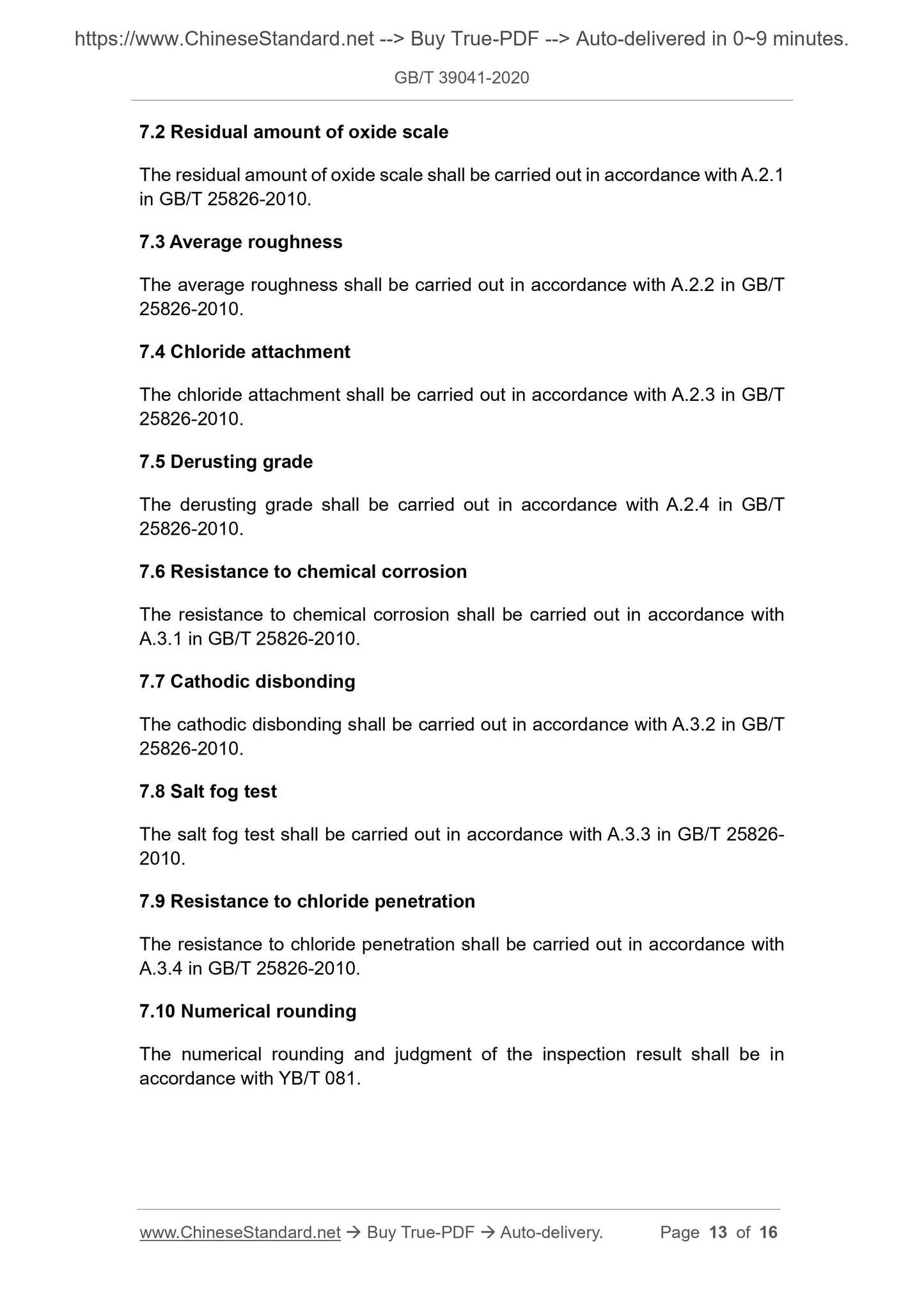1
/
of
7
PayPal, credit cards. Download editable-PDF & invoice in 1 second!
GB/T 39041-2020 English PDF (GBT39041-2020)
GB/T 39041-2020 English PDF (GBT39041-2020)
Regular price
$155.00 USD
Regular price
Sale price
$155.00 USD
Unit price
/
per
Shipping calculated at checkout.
Couldn't load pickup availability
Delivery: 3 seconds. Download true-PDF + Invoice.
Get QUOTATION in 1-minute: Click GB/T 39041-2020
Historical versions: GB/T 39041-2020
Preview True-PDF (Reload/Scroll if blank)
GB/T 39041-2020: Carbon steel-fiber reinforced plastic clad bars for reinforcement concrete
GB/T 39041-2020
GB
NATIONAL STANDARD OF THE
PEOPLE’S REPUBLIC OF CHINA
ICS 77.140.60
H 44
Carbon steel-fiber reinforced plastic clad bars for
reinforcement concrete
ISSUED ON: JULY 21, 2020
IMPLEMENTED ON: FEBRUARY 01 21, 2021
Issued by: State Administration for Market Regulation;
Standardization Administration of the People’s Republic of
China.
Table of Contents
Foreword ... 3
1 Scope ... 4
2 Normative references ... 4
3 Terms and definitions ... 6
4 Classification and designation... 7
5 Size, shape, weight and allowable deviation ... 9
6 Technical requirements ... 9
7 Test method ... 12
8 Inspection rules ... 14
9 Packaging, marking and quality certificate ... 15
Carbon steel-fiber reinforced plastic clad bars for
reinforcement concrete
1 Scope
This Standard specifies the terms and definitions, classification, designation,
size, shape, weight and allowable deviations, technical requirements, test
methods, inspection rules, packaging, marking and quality certification of
carbon steel-fiber reinforced plastic clad bars (hereinafter referred to as clad
bars).
This Standard applies to plain and ribbed bars which are made of carbon steel-
fiber reinforced plastics for reinforcement concrete.
2 Normative references
The following documents are indispensable for the application of this document.
For dated references, only the dated version applies to this document. For
undated references, the latest edition (including all amendments) applies to this
document.
GB/T 222, Permissible tolerances for chemical composition of steel products
GB/T 223.5, Steel and iron - Determination of acid-soluble silicon and total
silicon content - Reduced molybdosilicate spectrophotometric method
GB/T 223.11, Iron, steel and alloy - Determination of chromium content -
Visual titration or potentiometric titration method
GB/T 223.12, Methods for chemical analysis of iron, steel and alloy - The
sodium carbonate separation-diphenyl carbazide photometric method for the
determination of chromium content
GB/T 223.14, Methods for chemical analysis of iron, steel and alloy - The N-
benzoy-N-phenylhydroxylamine extraction photometric method for the
determination of vanadium content
GB/T 223.19, Methods for chemical analysis of iron, steel and alloy - The
neocuproine-chloroform extraction photometric method for the determination
of copper content
GB/T 17505, Steel and steel products - General technical delivery
requirements
GB/T 20018, Metallic and non-metallic coatings - Measurement of thickness
- Beta backscatter methods
GB/T 20123, Steel and iron - Determination of total carbon and sulfur content
Infrared absorption method after combustion in an induction furnace (routine
method)
GB/T 20124, Steel and iron - Determination of nitrogen content - Thermal
conductimetric method after fusion in a current of inert gas
GB/T 20125, Low-alloy steel. Determination of multi-element contents.
Inductively coupled plasma atomic emission spectrometric method
GB/T 25826-2010, Epoxy-coated steel for the reinforcement of concrete
GB/T 26743, Fiber reinforced composite bars for civil engineering
GB/T 28900, Test methods of steel for reinforcement of concrete
JGJ 18, Specification for welding and acceptance of reinforcing steel bars
JGJ 107, Technical specification for mechanical splicing of steel reinforcing
bars
YB/T 081, Rule for rounding off of numerical values and judgment of testing
values for technical standards of metallurgy
3 Terms and definitions
Terms and definitions determined by GB/T 1499.1, GB/T 1499.2, GB/T 26743
and the following ones are applicable to this document.
3.1 Carbon steel-fiber reinforced plastic clad bars
Clad bars, whose surface layer is fiber reinforced plastics and core is hot-rolled
steel bars, which is compounded through processes such as compression
molding, bonding, high-pressure injection, high-temperature treatment.
3.2 Base metal
The base metal of clad bars is mainly the hot-rolled steel bar that is used to
withstand the structural strength, which is divided into plain bars and ribbed
bars.
c) Clad bar designation (including the cladding designation);
d) Clad bar nominal diameter, length (or disk diameter) and weight (or
quantity, or disk weight);
e) Special requirements.
5 Size, shape, weight and allowable deviation
5.1 Nominal diameter range and recommended diameter
The nominal diameter of hot-rolled plain-fiber reinforced plastic clad bars is 6
mm ~ 22 mm; the nominal diameter of hot-rolled ribbed-fiber reinforced plastic
clad bars is 6 mm ~ 50 mm; the recommended nominal diameters of clad bars
are 6 mm, 8 mm, 10 mm, 12 mm, 14 mm, 16 mm, 18 mm, 20 mm, 22 mm, 25
mm, 28 mm, 32 mm, 36 mm, 40 mm and 50 mm.
5.2 Size, shape and allowable deviation
The size, shape and allowable deviation of the base metal of hot-rolled plain-
fiber reinforced plastic clad bars shall meet the requirements of GB/T 1499.1.
The size, shape and allowable deviation of the base metal of hot-rolled ribbed-
fiber reinforced plastic clad bars shall meet the requirements of GB/T 1499.2.
Special requirements shall be negotiated by both parties.
5.3 Cladding thickness
The cladding thickness size range is 0.07 mm ~ 1.0 mm.
5.4 Weight
It is delivered at actual weight.
6 Technical requirements
6.1 Materials
6.1.1 The chemical composition and carbon equivalent of the base metal of clad
bars shall comply with the relevant regulations of GB/T 1499.1 and GB/T 1499.2.
6.1.2 The chemical composition of the base metal of clad bars shall be indicated
in the quality certificate.
6.1.3 The steel base metal which is used to make clad bars shall avoid oil,
grease or paint pollution. Before compounding, it shall be visually confirmed
that the steel bar does not have sharp edges, burrs or other surface defects
6.5 Connection performance
6.5.1 Before the clad bars are connected, the surface cladding of the
connecting part shall be removed first; the position after the connection shall be
sealed with epoxy resin. Refer to the requirements of JGJ 18, JGJ 107 and
other relevant standards for the quality inspection and acceptance of the
welding, mechanical connection process and joints of clad bars.
6.5.2 The clad bars can also be connected by other connection methods. The
technical requirements and test methods of the test shall be negotiated and
determined by the supplier and the buyer.
6.5.3 The welding process of HRB500FC and HRB500FCE clad bars shall be
determined through experiments.
6.6 Surface quality
There shall be no defects that affect the performance on the surface of the clad
bars; the surface bumps of the ribbed clad bars shall not exceed the height of
the transverse ribs.
7 Test method
7.1 Dimension measurement and cladding thickness
7.1.1 The height of the transverse rib of the ribbed clad bar is measured by the
method of measuring the average value of the center height of the transverse
ribs on both sides of the same section, that is, measuring the maximum outer
diameter of the clad bar, and subtracting the inner diameter at the point; half
the obtained value is the rib height at that point, which shall be accurate to 0.1
mm. When it is necessary to calculate the relative rib area, a quarter of the
height of the measured transverse rib shall be added.
7.1.2 The transverse rib spacing of ribbed clad bars shall be measured ...
Get QUOTATION in 1-minute: Click GB/T 39041-2020
Historical versions: GB/T 39041-2020
Preview True-PDF (Reload/Scroll if blank)
GB/T 39041-2020: Carbon steel-fiber reinforced plastic clad bars for reinforcement concrete
GB/T 39041-2020
GB
NATIONAL STANDARD OF THE
PEOPLE’S REPUBLIC OF CHINA
ICS 77.140.60
H 44
Carbon steel-fiber reinforced plastic clad bars for
reinforcement concrete
ISSUED ON: JULY 21, 2020
IMPLEMENTED ON: FEBRUARY 01 21, 2021
Issued by: State Administration for Market Regulation;
Standardization Administration of the People’s Republic of
China.
Table of Contents
Foreword ... 3
1 Scope ... 4
2 Normative references ... 4
3 Terms and definitions ... 6
4 Classification and designation... 7
5 Size, shape, weight and allowable deviation ... 9
6 Technical requirements ... 9
7 Test method ... 12
8 Inspection rules ... 14
9 Packaging, marking and quality certificate ... 15
Carbon steel-fiber reinforced plastic clad bars for
reinforcement concrete
1 Scope
This Standard specifies the terms and definitions, classification, designation,
size, shape, weight and allowable deviations, technical requirements, test
methods, inspection rules, packaging, marking and quality certification of
carbon steel-fiber reinforced plastic clad bars (hereinafter referred to as clad
bars).
This Standard applies to plain and ribbed bars which are made of carbon steel-
fiber reinforced plastics for reinforcement concrete.
2 Normative references
The following documents are indispensable for the application of this document.
For dated references, only the dated version applies to this document. For
undated references, the latest edition (including all amendments) applies to this
document.
GB/T 222, Permissible tolerances for chemical composition of steel products
GB/T 223.5, Steel and iron - Determination of acid-soluble silicon and total
silicon content - Reduced molybdosilicate spectrophotometric method
GB/T 223.11, Iron, steel and alloy - Determination of chromium content -
Visual titration or potentiometric titration method
GB/T 223.12, Methods for chemical analysis of iron, steel and alloy - The
sodium carbonate separation-diphenyl carbazide photometric method for the
determination of chromium content
GB/T 223.14, Methods for chemical analysis of iron, steel and alloy - The N-
benzoy-N-phenylhydroxylamine extraction photometric method for the
determination of vanadium content
GB/T 223.19, Methods for chemical analysis of iron, steel and alloy - The
neocuproine-chloroform extraction photometric method for the determination
of copper content
GB/T 17505, Steel and steel products - General technical delivery
requirements
GB/T 20018, Metallic and non-metallic coatings - Measurement of thickness
- Beta backscatter methods
GB/T 20123, Steel and iron - Determination of total carbon and sulfur content
Infrared absorption method after combustion in an induction furnace (routine
method)
GB/T 20124, Steel and iron - Determination of nitrogen content - Thermal
conductimetric method after fusion in a current of inert gas
GB/T 20125, Low-alloy steel. Determination of multi-element contents.
Inductively coupled plasma atomic emission spectrometric method
GB/T 25826-2010, Epoxy-coated steel for the reinforcement of concrete
GB/T 26743, Fiber reinforced composite bars for civil engineering
GB/T 28900, Test methods of steel for reinforcement of concrete
JGJ 18, Specification for welding and acceptance of reinforcing steel bars
JGJ 107, Technical specification for mechanical splicing of steel reinforcing
bars
YB/T 081, Rule for rounding off of numerical values and judgment of testing
values for technical standards of metallurgy
3 Terms and definitions
Terms and definitions determined by GB/T 1499.1, GB/T 1499.2, GB/T 26743
and the following ones are applicable to this document.
3.1 Carbon steel-fiber reinforced plastic clad bars
Clad bars, whose surface layer is fiber reinforced plastics and core is hot-rolled
steel bars, which is compounded through processes such as compression
molding, bonding, high-pressure injection, high-temperature treatment.
3.2 Base metal
The base metal of clad bars is mainly the hot-rolled steel bar that is used to
withstand the structural strength, which is divided into plain bars and ribbed
bars.
c) Clad bar designation (including the cladding designation);
d) Clad bar nominal diameter, length (or disk diameter) and weight (or
quantity, or disk weight);
e) Special requirements.
5 Size, shape, weight and allowable deviation
5.1 Nominal diameter range and recommended diameter
The nominal diameter of hot-rolled plain-fiber reinforced plastic clad bars is 6
mm ~ 22 mm; the nominal diameter of hot-rolled ribbed-fiber reinforced plastic
clad bars is 6 mm ~ 50 mm; the recommended nominal diameters of clad bars
are 6 mm, 8 mm, 10 mm, 12 mm, 14 mm, 16 mm, 18 mm, 20 mm, 22 mm, 25
mm, 28 mm, 32 mm, 36 mm, 40 mm and 50 mm.
5.2 Size, shape and allowable deviation
The size, shape and allowable deviation of the base metal of hot-rolled plain-
fiber reinforced plastic clad bars shall meet the requirements of GB/T 1499.1.
The size, shape and allowable deviation of the base metal of hot-rolled ribbed-
fiber reinforced plastic clad bars shall meet the requirements of GB/T 1499.2.
Special requirements shall be negotiated by both parties.
5.3 Cladding thickness
The cladding thickness size range is 0.07 mm ~ 1.0 mm.
5.4 Weight
It is delivered at actual weight.
6 Technical requirements
6.1 Materials
6.1.1 The chemical composition and carbon equivalent of the base metal of clad
bars shall comply with the relevant regulations of GB/T 1499.1 and GB/T 1499.2.
6.1.2 The chemical composition of the base metal of clad bars shall be indicated
in the quality certificate.
6.1.3 The steel base metal which is used to make clad bars shall avoid oil,
grease or paint pollution. Before compounding, it shall be visually confirmed
that the steel bar does not have sharp edges, burrs or other surface defects
6.5 Connection performance
6.5.1 Before the clad bars are connected, the surface cladding of the
connecting part shall be removed first; the position after the connection shall be
sealed with epoxy resin. Refer to the requirements of JGJ 18, JGJ 107 and
other relevant standards for the quality inspection and acceptance of the
welding, mechanical connection process and joints of clad bars.
6.5.2 The clad bars can also be connected by other connection methods. The
technical requirements and test methods of the test shall be negotiated and
determined by the supplier and the buyer.
6.5.3 The welding process of HRB500FC and HRB500FCE clad bars shall be
determined through experiments.
6.6 Surface quality
There shall be no defects that affect the performance on the surface of the clad
bars; the surface bumps of the ribbed clad bars shall not exceed the height of
the transverse ribs.
7 Test method
7.1 Dimension measurement and cladding thickness
7.1.1 The height of the transverse rib of the ribbed clad bar is measured by the
method of measuring the average value of the center height of the transverse
ribs on both sides of the same section, that is, measuring the maximum outer
diameter of the clad bar, and subtracting the inner diameter at the point; half
the obtained value is the rib height at that point, which shall be accurate to 0.1
mm. When it is necessary to calculate the relative rib area, a quarter of the
height of the measured transverse rib shall be added.
7.1.2 The transverse rib spacing of ribbed clad bars shall be measured ...
Share
